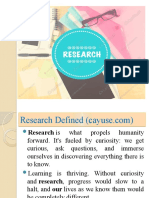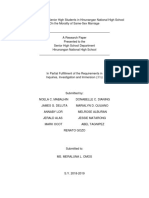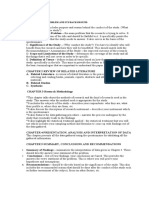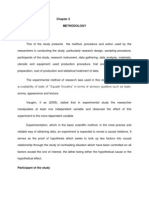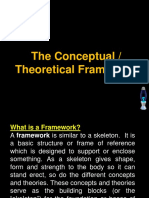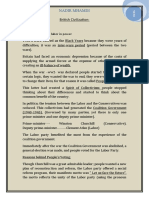100%(2)100% found this document useful (2 votes)
2K viewsHow To Write Chapter 5
How To Write Chapter 5
Uploaded by
PeterAndrewRegencia1. This document provides guidelines for writing Chapter 5 of a thesis, which typically includes a Summary, Summary of Findings, Conclusions, and Recommendations.
2. It outlines what should be included in each section, such as briefly restating the purpose, population, research methods, and findings in the Summary section.
3. The Summary of Findings, Conclusions, and Recommendations sections are then described in more detail regarding how to organize and present the results, draw conclusions, and provide practical suggestions.
Copyright:
© All Rights Reserved
Available Formats
Download as PDF, TXT or read online from Scribd
How To Write Chapter 5
How To Write Chapter 5
Uploaded by
PeterAndrewRegencia100%(2)100% found this document useful (2 votes)
2K views13 pages1. This document provides guidelines for writing Chapter 5 of a thesis, which typically includes a Summary, Summary of Findings, Conclusions, and Recommendations.
2. It outlines what should be included in each section, such as briefly restating the purpose, population, research methods, and findings in the Summary section.
3. The Summary of Findings, Conclusions, and Recommendations sections are then described in more detail regarding how to organize and present the results, draw conclusions, and provide practical suggestions.
Original Description:
Writing Chapter 5
Original Title
How to Write Chapter 5
Copyright
© © All Rights Reserved
Available Formats
PDF, TXT or read online from Scribd
Share this document
Did you find this document useful?
Is this content inappropriate?
1. This document provides guidelines for writing Chapter 5 of a thesis, which typically includes a Summary, Summary of Findings, Conclusions, and Recommendations.
2. It outlines what should be included in each section, such as briefly restating the purpose, population, research methods, and findings in the Summary section.
3. The Summary of Findings, Conclusions, and Recommendations sections are then described in more detail regarding how to organize and present the results, draw conclusions, and provide practical suggestions.
Copyright:
© All Rights Reserved
Available Formats
Download as PDF, TXT or read online from Scribd
Download as pdf or txt
100%(2)100% found this document useful (2 votes)
2K views13 pagesHow To Write Chapter 5
How To Write Chapter 5
Uploaded by
PeterAndrewRegencia1. This document provides guidelines for writing Chapter 5 of a thesis, which typically includes a Summary, Summary of Findings, Conclusions, and Recommendations.
2. It outlines what should be included in each section, such as briefly restating the purpose, population, research methods, and findings in the Summary section.
3. The Summary of Findings, Conclusions, and Recommendations sections are then described in more detail regarding how to organize and present the results, draw conclusions, and provide practical suggestions.
Copyright:
© All Rights Reserved
Available Formats
Download as PDF, TXT or read online from Scribd
Download as pdf or txt
You are on page 1of 13
HOW TO WRITE CHAPTER 5
Summary, Summary of Findings,
Conclusions, and Recommendations
PETER ANDREW G. REGENCIA, Ed.D., Ph.D. (cand)
Part-time Professor, EQC-MSC School of Advanced Education (SAEd)
• Discuss the Guidelines on how to write
Summary, Summary of Findings,
Conclusions, and Recommendations.
Alvior, M. G. (July 29, 2014). Thesis Writing: What to Write in Chapter 5. In
SimplyEducate.Me. Retrieved from https://simplyeducate.me/2014/07/29/
thesis-writing-what-to-write-in-chapter-5/
Relampagos, J. (2017). How to make research paper chapter 5: Summary,
Consclusion and Recommendation. Retrieved from
https://www.slideshare.net/JhenieRelampagos/how-to-make-research-paper-
chapter-5-summary-consclusion-and-recommentation?from_action=save
SUMMARY
1. What is the objective of the study?
There should be a brief statement
2. Who/what is the focus of the study?
about:
3. Where and when was the investigation
• the main purpose of the study
conducted?
• the population or respondents
4. What method of research was used?
• the period of the study
5. How were the research data gathered?
• method of research used
6. How were the respondents chosen?
• the research instrument
7. What statistical tools were applied to treat
• the sampling design
the gathered data?
SUMMARY
What is the objective of the study?
Who/what is the focus of the study?
This was conducted for the purpose of
determining the status of teaching science in
What method of research was used? the high schools of Province A. The descriptive
How were the research data gathered? method is used of research was utilized and
the nominative survey technique was used for
gathering data. The questionnaire served as
the instrument for collecting data. All the
How were the respondents chosen?
teachers handling science and a 20 percent
representative sample of the students were the
respondents. The inquiry was conducted
Where and when was the investigation conducted?
during the school year 2017-2018.
SUMMARY OF FINDINGS
CONCLUSIONS
• Draw out a conclusion from each finding or result.
• It can be done per question or you may arrange
the questions per topic or sub-topic, if there is
any.
• But if your research is quantitative in nature,
answer directly the research question and tell if
the hypothesis is rejected or accepted based on
the findings.
RECOMMENDATIONS
• The recommendations must contain
practical suggestions that will improve
the situation or solve the problem
investigated in the study.
RECOMMENDATIONS
• It must be logical, specific, attainable
and relevant.
RECOMMENDATIONS
• It should be addressed to persons,
organizations, or agencies directly concerned
with the issues or to those who can
immediately implement the recommended
solutions.
RECOMMENDATIONS
• Present another topic which is very relevant
to the present study that can be further
investigated by future researchers.
RECOMMENDATIONS
• Never recommend anything that is not part of
your study or not being mentioned in your
findings.
You might also like
- Chapter 2 Methodology Sample GuideDocument7 pagesChapter 2 Methodology Sample GuidekentryzbustamanteNo ratings yet
- Script For A Better Malaysia - DSAIDocument186 pagesScript For A Better Malaysia - DSAIMOHD SYAZWAN BIN JONIT (MOE)No ratings yet
- Porouse Concret 6th Sem Project - AllDocument22 pagesPorouse Concret 6th Sem Project - AllVaibhav 2401No ratings yet
- Research Presentation - Chapter 1Document17 pagesResearch Presentation - Chapter 1Rengeline LucasNo ratings yet
- Self-Learning Package: Quantitative ResearchDocument10 pagesSelf-Learning Package: Quantitative ResearchCrysse PartisalaNo ratings yet
- How To Write Chapter 1 of A ThesisDocument2 pagesHow To Write Chapter 1 of A ThesisApril Unde76% (29)
- Module 3 The Marketing PlanDocument50 pagesModule 3 The Marketing Planjulietpamintuan80% (5)
- Discuss Here The Parts of The MethodologyDocument3 pagesDiscuss Here The Parts of The MethodologyPhine Alota100% (1)
- PR-1-GROUP-5-CHAPTER-1-3 FinalDocument13 pagesPR-1-GROUP-5-CHAPTER-1-3 FinalAngelicka ErishNo ratings yet
- Troubleshooting Problem 5.1: Mass Balance With Recycle StreamsDocument10 pagesTroubleshooting Problem 5.1: Mass Balance With Recycle Streamsmilton ochoaNo ratings yet
- PR2 Defense Chapt1 3Document58 pagesPR2 Defense Chapt1 3sharonNo ratings yet
- Quantitative Research ProblemDocument35 pagesQuantitative Research ProblemSir NajNo ratings yet
- Schematic Diagram and Statement of The ProblemDocument3 pagesSchematic Diagram and Statement of The ProblemRENDON GARCIANo ratings yet
- Characteristics of A ResearchDocument3 pagesCharacteristics of A ResearchAndré James FadrigalanNo ratings yet
- Chapter 5Document11 pagesChapter 5Carmina CastilloNo ratings yet
- Research TitleDocument6 pagesResearch TitlenorizanNo ratings yet
- JerishaneDocument2 pagesJerishaneJerishane DiwaNo ratings yet
- Dependent Independent: Compare and Contrast 3Document1 pageDependent Independent: Compare and Contrast 3kent joshua pamaNo ratings yet
- Nature of Qualitative Research ParcticalDocument7 pagesNature of Qualitative Research ParcticalJulia FlorencioNo ratings yet
- Capstone Paper Materials and MethodsDocument6 pagesCapstone Paper Materials and MethodsKenny MainaNo ratings yet
- Sample Research Paper (CHAPTER 1-3)Document22 pagesSample Research Paper (CHAPTER 1-3)Ain SoberanoNo ratings yet
- Background of The Study-PrintDocument1 pageBackground of The Study-PrintreyiNo ratings yet
- Impact of Socio-Economic Status On Academic Achievement Among The Senior Secondary School StudentsDocument7 pagesImpact of Socio-Economic Status On Academic Achievement Among The Senior Secondary School StudentsThalia KimNo ratings yet
- The 3 I's: Inquiry, Investigation and ImmersionDocument5 pagesThe 3 I's: Inquiry, Investigation and Immersionaiko teodoroNo ratings yet
- General Instructions: Critique The Picture Below Applying The Different Principles in Critiquing The Art Piece Such As 1. Description 2. Analysis 3. Interpretation 4. JudgementDocument4 pagesGeneral Instructions: Critique The Picture Below Applying The Different Principles in Critiquing The Art Piece Such As 1. Description 2. Analysis 3. Interpretation 4. JudgementOrsi CabangibangNo ratings yet
- Chapter 2 MethodologyDocument2 pagesChapter 2 MethodologyGlenda ValerosoNo ratings yet
- Chapter III MethodologyDocument4 pagesChapter III MethodologyteamscribeNo ratings yet
- The Perception of Senior High Students in Hinunangan National High School On The Morality of SameDocument27 pagesThe Perception of Senior High Students in Hinunangan National High School On The Morality of SameEdgar Ian HomediaNo ratings yet
- School Canteen LiteratureDocument3 pagesSchool Canteen LiteratureAlger50% (2)
- 33333333Document11 pages33333333Marivic Betis RubidoNo ratings yet
- Chapter 1 The Problem and Its BackgroundDocument1 pageChapter 1 The Problem and Its Backgroundolive baon100% (1)
- Importance of Quantitative Research Across Various FieldsDocument14 pagesImportance of Quantitative Research Across Various FieldsTyroneJames Mary Ann Balatbat100% (1)
- Chapter 2Document8 pagesChapter 2Fidess Marie Malcaba AgbisitNo ratings yet
- Human Variation: Ucsp - First QuarterDocument24 pagesHuman Variation: Ucsp - First QuarterIgnatians Santa Rosa100% (1)
- Local RRL 2Document77 pagesLocal RRL 2sheila rose lumaygayNo ratings yet
- Theoretical Conceptual FrameworkDocument19 pagesTheoretical Conceptual FrameworkMaria Arlene100% (1)
- Parts of A ResumeDocument3 pagesParts of A ResumeMa Joville Robles Tabefranca100% (1)
- Chapters 1 To 5 PDFDocument67 pagesChapters 1 To 5 PDFCarllouie De LaraNo ratings yet
- How Different Time-Management Techniques Affect The Academic Performance of A Senior High-School StudentDocument18 pagesHow Different Time-Management Techniques Affect The Academic Performance of A Senior High-School StudentJan Ivan MontenegroNo ratings yet
- 5 Types of Quantitative Research DesignDocument6 pages5 Types of Quantitative Research DesignJonn EngueroNo ratings yet
- Types of Research DesignsDocument27 pagesTypes of Research DesignsrrachellevNo ratings yet
- Likert ScaleDocument5 pagesLikert ScaleCART11No ratings yet
- Quantitative Research - Data GatheringDocument15 pagesQuantitative Research - Data Gatheringmili bobby brown100% (1)
- Practical Research 2 Week 1 q2Document9 pagesPractical Research 2 Week 1 q2jeo nalugon0% (1)
- Factors Affecting Grade 12 Gas Students' Participation in The Asynchronous Online Learning at Bicol College, Daraga, AlbayDocument46 pagesFactors Affecting Grade 12 Gas Students' Participation in The Asynchronous Online Learning at Bicol College, Daraga, AlbayFunny JuanNo ratings yet
- Lesson 2 - Generating Ideas - Harnessing Logic and Creativity p.1Document15 pagesLesson 2 - Generating Ideas - Harnessing Logic and Creativity p.1Michelle Rotairo67% (3)
- Theoritical FrameworkDocument4 pagesTheoritical FrameworkBryan Clareza0% (1)
- Assumption of The StudyDocument1 pageAssumption of The StudyMoselina HazelNo ratings yet
- Review of Related Literature and StudiesDocument25 pagesReview of Related Literature and StudiesIhla Katrina Reyes TubiganNo ratings yet
- Chapter IIIDocument12 pagesChapter IIIkevinmanansala26No ratings yet
- Title Defense: Title 1: Professional Qualities of Early Childhood EducationDocument30 pagesTitle Defense: Title 1: Professional Qualities of Early Childhood EducationRainiel Victor M. CrisologoNo ratings yet
- Chapter 3 in Practical ResearchDocument5 pagesChapter 3 in Practical Researchjenchulichaeng blinkue100% (1)
- Estancia National High SchoolDocument25 pagesEstancia National High SchoolYahuah Lene Crisostomo0% (1)
- Using Interviews As Research InstrumentsDocument10 pagesUsing Interviews As Research InstrumentsArlene Cerdeña Salceda100% (1)
- Lesson 2 - Quantitative ResearchDocument9 pagesLesson 2 - Quantitative ResearchMark ElbenNo ratings yet
- Definition of TermsDocument3 pagesDefinition of TermsIrish OrleansNo ratings yet
- Data Gathering Instrument Problem StatementDocument1 pageData Gathering Instrument Problem StatementRenecy JoyNo ratings yet
- Title Page With TOC Format Finale 3Document28 pagesTitle Page With TOC Format Finale 3Aisy Acabal ErojoNo ratings yet
- Mixed Methods Research Designs: LinkDocument6 pagesMixed Methods Research Designs: LinkQuerobin GampayonNo ratings yet
- A Study On The Impact of Free Shipping Service On The Online Purchasing Behavior of CustomersDocument48 pagesA Study On The Impact of Free Shipping Service On The Online Purchasing Behavior of CustomersJASKIRAT SINGH100% (1)
- IMRADDocument23 pagesIMRADCamille Jung83% (6)
- EFFECTIVENESS-OF-UTILIZING-RECYCLED-ELECTRIC-FAN-MOTOR-IN-GENERATING-ELECTRICITY-latest-mao-ni-ang-final (Repaired)Document23 pagesEFFECTIVENESS-OF-UTILIZING-RECYCLED-ELECTRIC-FAN-MOTOR-IN-GENERATING-ELECTRICITY-latest-mao-ni-ang-final (Repaired)Ruzui100% (1)
- Research ReviewerDocument97 pagesResearch ReviewerLeanzon PanganibanNo ratings yet
- Office Performance Commitment and Review Form (Opcrf) : Annex EDocument18 pagesOffice Performance Commitment and Review Form (Opcrf) : Annex EPeterAndrewRegencia100% (2)
- District In-Service Training (Semestral Break) : Teaching-Learning Observation ChecklistDocument2 pagesDistrict In-Service Training (Semestral Break) : Teaching-Learning Observation ChecklistPeterAndrewRegenciaNo ratings yet
- Activity Plan For Math Fair 2016Document1 pageActivity Plan For Math Fair 2016PeterAndrewRegenciaNo ratings yet
- Activity Plan For Math Fair 2016Document2 pagesActivity Plan For Math Fair 2016PeterAndrewRegenciaNo ratings yet
- EapDocument83 pagesEapPeterAndrewRegencia0% (1)
- Fourth Periodical Examination Fourth Periodical Examination: Grade 7 Mathematics Grade 7 MathematicsDocument2 pagesFourth Periodical Examination Fourth Periodical Examination: Grade 7 Mathematics Grade 7 MathematicsPeterAndrewRegenciaNo ratings yet
- Advantages and Disadvantages of Block Scheduling PDFDocument5 pagesAdvantages and Disadvantages of Block Scheduling PDFPeterAndrewRegenciaNo ratings yet
- English For Academic Purposes: Extra ActivitiesDocument1 pageEnglish For Academic Purposes: Extra ActivitiesPeterAndrewRegenciaNo ratings yet
- Summer Tutorial AdverbsDocument2 pagesSummer Tutorial AdverbsPeterAndrewRegenciaNo ratings yet
- Summer Tutorial PronounsDocument2 pagesSummer Tutorial PronounsPeterAndrewRegenciaNo ratings yet
- Summer Tutorial VerbsDocument3 pagesSummer Tutorial VerbsPeterAndrewRegenciaNo ratings yet
- Summer Tutorial NounsDocument2 pagesSummer Tutorial NounsPeterAndrewRegenciaNo ratings yet
- Summary Disaster RecoveryDocument4 pagesSummary Disaster RecoveryRachel E. Stassen-BergerNo ratings yet
- English BookDocument11 pagesEnglish BookVisal WassanaNo ratings yet
- TR50502SSLPT4WFRBR UpdatedDocument117 pagesTR50502SSLPT4WFRBR UpdatedVinicius JoseNo ratings yet
- Soalan Assignment - CBMS4303Document8 pagesSoalan Assignment - CBMS4303aku kacakNo ratings yet
- ESP32 Bluetooth Low Energy Tracker Hub - ESPHomeDocument4 pagesESP32 Bluetooth Low Energy Tracker Hub - ESPHomeh2oo2hNo ratings yet
- British CivilisationDocument12 pagesBritish CivilisationMina AmounaNo ratings yet
- Regression Analysis Linear and Multiple RegressionDocument6 pagesRegression Analysis Linear and Multiple RegressionPauline Kay Sunglao GayaNo ratings yet
- Atom PaglaumDocument78 pagesAtom PaglaumAldrinmarkquintanaNo ratings yet
- Presentation On Decision MakingDocument17 pagesPresentation On Decision MakingGunjan100% (3)
- Company Law SyllabusDocument5 pagesCompany Law SyllabusAbid CoolNo ratings yet
- Resume PDFDocument1 pageResume PDFHelloNo ratings yet
- Tak Tik Book - Movie Tickets & Movie Times Sri LankaDocument1 pageTak Tik Book - Movie Tickets & Movie Times Sri LankaGaming OfficerNo ratings yet
- Payeurl,: Beriault'Document6 pagesPayeurl,: Beriault'infodotzNo ratings yet
- 3 Lifeline CPVC Hot and Cold Plumbing SystemDocument4 pages3 Lifeline CPVC Hot and Cold Plumbing SystemsaranNo ratings yet
- Banking Laws Case DigestDocument4 pagesBanking Laws Case DigestAl Shannen Nicole LabraNo ratings yet
- MT3608Document8 pagesMT3608Anderson Ferreira RodriguesNo ratings yet
- Indian Standard: Quality Control During Construction OF Earth and Rockfill Dams - RecommendationsDocument16 pagesIndian Standard: Quality Control During Construction OF Earth and Rockfill Dams - RecommendationsGolak PattanaikNo ratings yet
- 1 Gepco 1011Document1 page1 Gepco 1011khanNo ratings yet
- Dy vs. Koninklijke Philips Electronics, N.V. (G.R. No. 186088 March 22, 2017)Document3 pagesDy vs. Koninklijke Philips Electronics, N.V. (G.R. No. 186088 March 22, 2017)ellavisdaNo ratings yet
- DMN - 34-799 - Distribution Technology Home - EskomDocument28 pagesDMN - 34-799 - Distribution Technology Home - EskomSerik ZhilkamanovNo ratings yet
- LAS-Applied-Chem-Melc-2-for-students - For MergeDocument18 pagesLAS-Applied-Chem-Melc-2-for-students - For MergeKrize Anne CornejaNo ratings yet
- Corporate FinanceDocument63 pagesCorporate FinanceVinanceNo ratings yet
- Loan AgreementDocument2 pagesLoan AgreementKristine Jane Manalastas CullaNo ratings yet
- Vault Pro ManualDocument94 pagesVault Pro ManualBima SeptiantoroNo ratings yet
- Rizal'S New PropertyDocument3 pagesRizal'S New PropertySheni CasinathanNo ratings yet
- R.A. 9775 - Anti Child PornographyDocument22 pagesR.A. 9775 - Anti Child PornographyChristia Sandee SuanNo ratings yet
- Cisa C3000Document8 pagesCisa C3000Yasin ElaswadNo ratings yet



